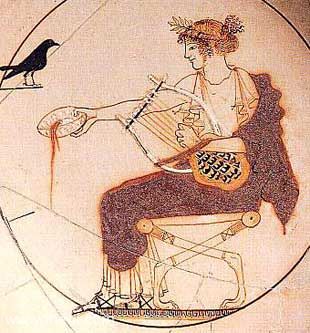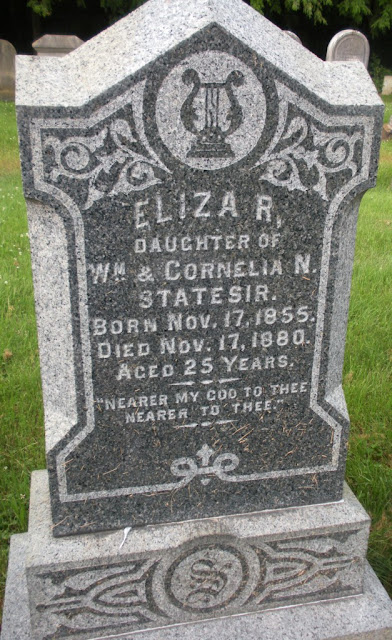.JPG) |
| Rosedale Cemetery, Montclair, NJ |
"Awake, thy last sad voice, my harp!
The voice of woe and wild despair!
Awake, resound thy latest lay!
The sleep in silence evermair!
And thou, my last, best, only friend,
That fillest an untimely tomb,
Accept this tribute from the Bard
Thou brought from Fortune's mirkest gloom."
---excerpt from Lament for James, Earl of Glencairn,
Robert Burns (1759-1796)
James Cunningham, the 14th Earl of Glencairn, was a close friend and patron of poet Robert Burns in the late 18th century. When Cunningham died, Burns wrote this elegy to Cunningham's sister, adding in a letter, "God knows what I have suffered at the loss of my best Friend, my first my dearest Patron and Benefactor; the man to whom I owe all that I am and have!"
I added this poem to my blog since it mentions both the harp and death. Too bad Robert Burns was Scottish, as the harp or lyre is a typical symbol of Ireland, and a harp on a grave could represent the Irish heritage of the deceased. Harps also symbolized heavenly music, as they were considered the instruments of angels.
Many of the gravestones below are adorned with lyres, which are smaller than harps, and can be held in the hands while being played. Lyres are usually associated with the Greek god Apollo, the god of music and poetry (among other things), and he is frequently portrayed with the lyre.
 |
| Apollo, god of music, Athenian red-figure kylix C5th B.C., Archaeological Museum of Delphi |
Sometimes the lyre or harp on the gravestone will have a broken string, symbolizing the mortal life that has ended. The most interesting carvings I have found are in the Philadelphia/Norristown area. It seems to be a lyre or harp but the arms and base seem to be a spiky plant. I haven't been able to find out what type of plant it is (my botanical friends, email me with your thoughts). It might be a type of century plant, or agave, which represents longevity and immortality, since the agave plant is a succulent with spiky edges and is long-lived. But I can't find any tall agave plants; they are usually short but wide. So another mystery continues....
 |
| Thomas K. Thomas only has this metal marker, but it has a nice lyre. Belfast Union Cemetery, Belfast, PA |
 |
| Bethany Presbyterian Cemetery, Bethany, PA |
 |
| A harp on a zinc monument, Chase Cemetery, Fleetville, PA |
 |
| Effort Cemetery, Effort, PA |
 |
| Elmwood Cemetery, Shepherdstown, WV |
 |
| Laurel Hill Cemetery, Philadelphia, PA |
 |
| Laurel Hill Cemetery, Philadelphia, PA |
 |
| Laurel Hill Cemetery, Philadelphia, PA |
 |
| Laurel Hill Cemetery, Philadelphia, PA |
 |
| Middle Creek Cemetery, Effort, PA |
 |
| Middle Creek Cemetery, Effort, PA |
 |
| This one has a broken string, Old Brick Reformed Church Cemetery, Freehold, NJ |
 |
| West Swamp Mennonite Cemetery, Quakertown, PA |
 |
| Woodlands Cemetery, Philadelphia, PA |
 |
| The whole monument, Woodlands Cemetery, Philadelphia, PA |
 |
| Mount Pleasant Cemetery, Newark, NJ |
 |
| Evergreen Cemetery, Gettysburg, PA |
 |
| Here is the start of my collection of the lyre and spiky plant. Jeffersonville Presbyterian Cemetery, Jeffersonville, PA |
 |
| Laurel Hill Cemetery, Philadelphia, PA |
 |
| Laurel Hill Cemetery, Philadelphia, PA |
 |
| Laurel Hill Cemetery, Philadelphia, PA |
 |
| Laurel Hill Cemetery, Philadelphia, PA |
 |
| Laurel Hill Cemetery, Philadelphia, PA |
No comments:
Post a Comment